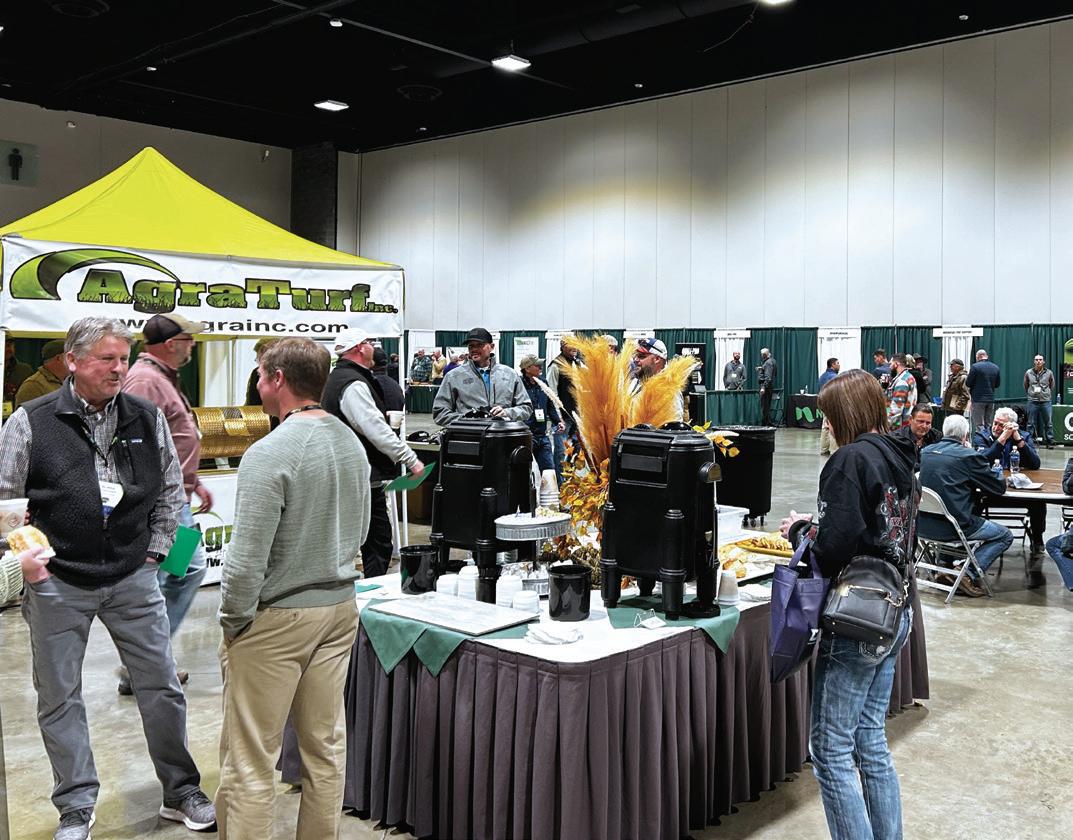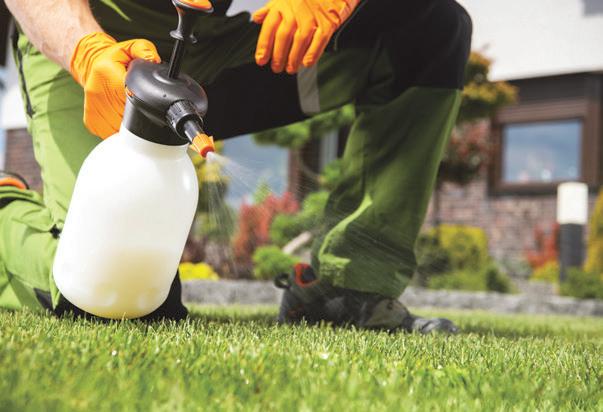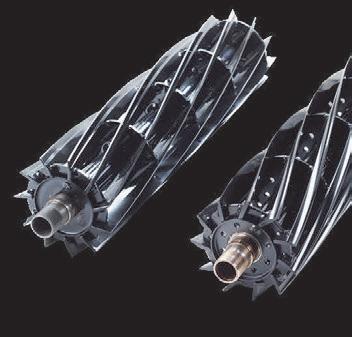THE ARKANSAS TURFGRASS ASSOCIATION MAGAZINE • SPRING 2025
Arkansas Turfgrass Association
P.O. Box 1862 • Lowell, AR 72745
Tel: 479-301-5534
Published by:
Leading Edge Communications, LLC
206 Bridge Street, Suite 200 Franklin, TN 37064
Tel: 615-790-3718
Email: info@leadingedge communications.com
ATA OFFICERS
Richard Covert, President Baptist Health Systems Richard.covert@baptist-health.org
Kyle Sanders, Immediate Past President Sanders Ground Essentials 501-315-9395 kylesanders@sandersground.com
Courtney Landreth Executive Director ataturfgrass@gmail.com
Wendell Hutchens, Ph.D., Educational Chair wendellh@uark.edu
Seth Dunlap Arkansas State Plant Board seth.dunlap@agriculture.arkansas.gov 501-225-1598
Daniel Baxley Parks & Recreation Director of Mountain Home dbaxley@cityofmountainhome.com
Brandon Bradley Picture Perfect Lawns brandon@pictureperfectlawns.com
Rodney Fisher Agra Turf, Inc. • 501-268-7036 agrarod@yahoo.com
Josh Landreth, Vice President Ace of Blades • 479-530-7001 aceofblades@cox.net
Guy Oyler
Jerry Pate Turf & Irrigation goyler@jerrypate.com • 501-317-5980
Jay Randolph
Sebastian County Park Admin. & Golf Course Superintendent jrandolph@co.sebastian.ar.us
Ricky Self Cypress Creek r.self@yahoo.com • 501-605-8000
Specialty Distribution
Rodney Fisher
PO Box 9168 Searcy, AR 72145 www.agrainc.com
Email: agrarod@yahoo.com
Winter Weather

Being responsible for all of the Baptist Health Grounds in the state is a large enough task already. Ten hospitals spread across the state from Monticello to Heber Springs all the way over to Ft. Smith. They all have different needs based on a number of things. One event that is the same no matter where its located is snow or ice. The latest snow and ice event on January 9th this year tested every resource we had. Some places you can let sit until it’s over, but a hospital is a different story. We have to keep whatever falls cleared all day and all night. Plow trucks with hoppers full of ice melt move nonstop. Skid loaders push and pile snow wherever it can be. As the days go on until the snow finally stops, we work it until its gone. Unfortunately, a lot of snow gets piled on turf and flower beds with seasonal color. Most of the time our only choice is to pile it on the grass, and as we plow and move snow the piles get larger and larger. At one point at the Little Rock Hospital we had a pile of snow that stretched 300 feet and averaged 15 feet high.
Being a turf guy, I was concerned when I saw this, especially if there was any ice melt in them. So, several trips with a 13-yard bed dump truck later we cleared that area. Many remain along with pieces of asphalt and speedbumps mixed in. Some of the piles we made probably wouldn’t melt until May! When the snow finally melts and you survey the damage, you see damaged turf, damaged irrigation heads and broken concrete. It’s all part of it, but getting large piles of snow off the turf is important for several reasons. One reason is snow mold can develop and if residual ice melt is mixed in, it can affect the soil pH which can cause discoloration and other issues. The only benefit I can see with snow is when it melts it helps water the grass and shrubs.
If you were unable to attend the annual conference this past January, we had a tremendous turnout filled with educational sessions and vendors showing off their latest equipment. We awarded three scholarships and had Dr. Aaron Patton from Perdue with us. A special thank you to our Executive Director Courtney Landreth and our Board members that work most of the year preparing for such an undertaking. It takes a lot of hard-working people giving selfless time to put these events together. We encourage you if you haven’t seen us in a while to come be a part of it in 2026.
Richard Covert ATA President
OF ARKANSAS TURF TEAM
Mike Richardson, Ph.D. Professor 479-575-2860
mricha@uark.edu
Wendell Hutchens, Ph.D. Assistant Professor of Turfgrass Science University of Arkansas, Department of Horticulture Cell: 276-952-8186 Office: 479-575-6205
wendellh@uark.edu X / Twitter: @HutchensWendell
Hannah Wright Smith Weed Specialist-Turfgrass, Specialty Crops, & Forestry 501-251-4416 hw044@uark.edu
John H. McCalla Jr. Program Technician III 479-575-5033
jmccall@uark.edu
The statements and opinions expressed herein are those of the individual authors and do not necessarily represent the views of the Arkansas Turfgrass Association, its staff, or its board of directors, Arkansas Turfgrass, or its editors. Likewise, the appearance of advertisers, or their identification as Arkansas Turfgrass Association members, does not constitute an endorsement of the products or services featured in this, past or subsequent issues of this quarterly publication. Copyright © 2025 by the Arkansas Turfgrass Association. Arkansas Turfgrass is published quarterly. Subscriptions are complimentary to members of the Arkansas Turfgrass Association. Third-class postage is paid at Jefferson City, MO. Printed in the U.S.A. We are not responsible for unsolicited freelance manuscripts and photographs. Contact the managing editor for contribution information.
Envu
www.jacksonsand.com
HIGHLIGHTS FROM THE
The Status of Herbicide Resistant Weeds in Turfgrass Systems
By Tripp Rogers and Travis Gannon
Tripp Rogers is a Ph.D. candidate under the direction of Dr. Travis Gannon in the Department of Crop and Soil Sciences at North Carolina State University.
Dr. Travis Gannon is a Professor in the Department of Crop and Soil Sciences at North Carolina State University.
Herbicide-resistant weeds are a leading problem in the turfgrass industry. Herbicide-resistant weed biotypes within a population may compromise the functionality and aesthetic of turfgrass systems while simultaneously imparting social and economic pressure on professional turfgrass managers.
What is herbicide resistance? Herbicide-resistant weeds are not a new problem in turfgrass systems (or any system). In fact, herbicide resistance was documented as early as 1970. Herbicide resistance is a selection process that develops through the repeated use of the same herbicide or herbicides with the same mechanism of action (MOA). Typically, herbicide resistance traits are present within a population at very low levels (~< 0.001%) (Petelewicz et al. 2023) and the continuous application of the same herbicide (or herbicide with same MOA) over time removes susceptible plants while allowing resistant individuals to survive, grow, reproduce, and proliferate.
Herbicide resistance can be characterized by cross- and multiple-resistance. Cross-resistance is defined as a population that is resistant to other herbicides or chemical families within the same MOA. For example, a population may be resistant to imidazolinones and sulfonylureas, which are both acetolactate synthase (ALS)-inhibiting [Herbicide Resistance Action Committee (HRAC) Group 2] herbicides. Multiple-resistance refers to weed populations that are resistant to herbicides with different MOAs. An example would be a population that is resistant to both ALS-inhibiting (HRAC Group 2) herbicides and photosystem (PS) II-inhibiting (HRAC Group 5) herbicides such as atrazine or simazine. Although cross-resistance is more common; multiple-resistant weeds are often more problematic, as control options are inherently more limited. The most effective method to mitigate cross-resistance is to rotate MOAs. However, managing multiple-resistant weed populations may require implementing other means of weed control outside of chemical control such as mechanical (i.e., fraise mowing) or cultural control practices.
Specifically, in turfgrass systems, herbicide resistance has been reported for annual bluegrass, goosegrass, shortleaf spikesedge, lawn burweed, annual sedge, spotted spurge, smooth crabgrass, large crabgrass, and buckhorn plantain, among others (Heap 2024). Annual bluegrass is arguably the most problematic herbicide-resistant weed in turfgrass systems. Reports have identified resistance in annual bluegrass populations to 9 unique MOAs in turfgrass systems. Reported resistance sites of action in turfgrass systems include HRAC groups 1, 2, 3, 5, 9, 10, 14, 27 and 29 (Table 1). Additionally, two annual bluegrass populations have been characterized as multiple resistant, with one population from Tennessee documented resistance to 7 MOAs. Similar to other species, herbicide-resistant goosegrass is also problematic; reports have documented resistance to 3 unique MOAs.
What has contributed to herbicide resistance in turfgrass systems? In short, there are a number of factors that have contributed to this phenomenon; however, overreliance on herbicides over time is a primary contributor coupled with not rotating herbicide MOAs. It’s also important to note, herbicides with new and novel mechanisms of action have been very limited in recent years (which limits turfgrass managers ability to rotate MOAs), particularly in certain turfgrass systems or use scenarios such as cool-season turfgrass or golf course putting greens. Policy (i.e. new regulations for oxadiazon) changes may also continue to limit herbicide options for many end-users.
What should turfgrass managers do to prevent or delay resistance?
1. Promote a healthy, thick turfgrass sward. Weeds are opportunistic and most are less likely to establish in thick, healthy turfgrass systems where there is natural competition. Common methods for promoting healthy turfgrass systems include scouting for disease pressure, proper fertilization and irrigation methods as well as ensuring that stands are mowed at the appropriate height and frequency.
2. Implement integrated weed management (IWM) strategies. It’s important to employ various integrated (preventative, mechanical, chemical, cultural, etc.) weed management techniques and not rely solely on herbicides.
3. When using herbicides, rotate MOAs. Less expensive herbicides may be effective initially, but overreliance on these products significantly increases the likelihood of resistance (and greater
associated costs) in the long-term. While it may be counterintuitive to switch to a potentially more expensive product, it may be necessary to mitigate or delay resistance. It is recommended to look at your herbicide program and reassess often.
4. Use MOAs with PRE and POST activity within a season. An example of this for controlling annual bluegrass in nonoverseeded bermudagrass could be using a PRE herbicide
Table 1. Herbicide resistant weeds reported in turf systems a
(examples include indaziflam, prodiamine, pendimethalin, simazine, among others) at optimum PRE timing for your location with a POST herbicide (examples include foramsulfuron, flazasulfuron, rimsulfuron, sulfosulfuron, trifloxysulfuron, among others) applied early POST. Turfgrass managers could also delay the initial application and combine PRE and POST herbicides into a single application (tank-mix). When feasible, well-timed applications of non-selective herbicides such as glyphosate or glufosinate may also enhance efficacy while including an additional MOA. It should be noted that many warm-season grass species have more selective POST herbicide options compared to cool-season turfgrass species, which makes using multiple MOAs more practical. It’s also important to note POST herbicides should always be applied to small, actively growing weeds to obtain optimal control.
5. Use the appropriate labeled herbicide rate to maximize efficacy (and minimize escapes). Sub-lethal herbicide rates may expedite resistance evolution. By using a lower rate, you remove the most susceptible plants and select for plants with resistance potential. If uncertain, consult herbicide labels and/or Extension personnel to ensure you apply the appropriate rate.
6. Ensure environmental and edaphic (soil) conditions are optimal. Conditions should be monitored prior to, at, and following application.
Identification of resistant populations and what resulted in reduced efficacy if I don’t have resistance? The Herbicide Resistance Action Committee (HRAC) states resistance must be confirmed by an unbiased scientist through a comparison of resistant and susceptible plants of the same species in a replicated scientific sound trial. In practice today, resistance is confirmed primarily by conducting a dose-response study utilizing various rates of an herbicide. This allows scientists to determine at which dose the population is controlled and ultimately confirm herbicide resistance. This method of resistance confirmation is not practical for professional turfgrass managers in a field setting. Additionally, there are several university-based laboratories that can confirm if your weed is resistant to a given herbicide or MOA. In the future, it’s likely various methods will be available that allow for rapid diagnosis of herbicide-resistant weed biotypes.
Just because you did not obtain control after an application does not confirm herbicide resistance as there are multiple reasons why an herbicide application may have been unsuccessful. Therefore, it is helpful to run through a checklist to determine if there was an application error or adverse environmental factors, which may have compromised herbicide efficacy.
• Was the herbicide applied at the correct time? This is especially important for preemergent (PRE) herbicide applications. PRE herbicides should be applied based on environmental conditions (i.e. soil temperature and moisture content), not calendar dates. This ensures the herbicide persists through critical periods of weed germination and/or emergence. For some weeds, these periods can extend beyond the residual activity of a single PRE application (depending on the herbicide), warranting
consideration of split- or sequential application programs. If foliar-absorbed postemergent (POST) herbicides are applied in winter and adequate control is not observed, it does not confirm resistance. If the plant is not actively growing at herbicide application, the herbicide may not have been adequately absorbed and / or translocated.
• Was the area mown soon after application? Mowing may influence herbicide efficacy. Not only can mowers physically move herbicides off target, but the removal of grass clippings may remove herbicides from the system.
• Was there a rainfall or irrigation event that could have moved the herbicide? Herbicides have varying rates of aqueous solubility that determine how tightly the herbicide is bound to the soil. While PRE herbicides need irrigation or rainfall, if a product is highly water soluble and has low soil-binding affinity, excessive rainfall or irrigation may move the herbicide off-target, potentially compromising efficacy.
• Was the herbicide applied to a saturated soil or did the soil become saturated after application? In anaerobic soils (saturated), some herbicides may break down much faster than in aerobic conditions. It’s important to ensure that herbicides are applied when environmental and edaphic conditions are favorable for optimal control. Recognizing that managers don’t have control over environmental or edaphic conditions after application, it remains important to be cognizant of how these conditions may influence herbicide persistence and / or efficacy.
If you can rule out the aforementioned factors that could influence herbicide efficacy, it’s time to ask a few more questions related to herbicide resistance:
– Has the herbicide historically controlled the target weed at this location? Has control declined after years of continuous use?
– Are dying plants intermingled with unaffected plants in the treated area?
– Are there other weed species in the treated area that are controlled?
If you answered yes to the above questions, resistance may be present and it’s likely worth additional investigation.
What can turfgrass managers do if resistance is confirmed? If an herbicide-resistant biotype is identified, it is extremely important to act quickly. If left unchecked, a resistant population can contribute to the soil seed bank. This means you could be dealing with resistance issues (at this site) for the next 7–10 years, depending on multiple factors including species and seed bank dynamics. However, there are some steps turfgrass managers can take to address resistant weed populations.
Switch to an herbicide with a different MOA. This is the easiest way to manage a resistant biotype. Managers should make sure they are switching MOAs and not just products (with same MOA). For example, if you suspect resistance to trifloxysulfuron (‘Monument’), switching to foramsulfuron (‘Revolver’)
most likely will not control the resistant population, as these are both ALS-inhibiting sulfonylurea herbicides. Resistance to one likely means you have resistance to the other.
As highlighted before, not all herbicides can be used in all turfgrass systems or use scenarios. Turfgrass managers should consider where they can incorporate various aspects of integrated weed management:
• If the resistant weed is confined to a small area, mechanical and / or cultural control (fraze (also spelled as frase, fraise, fraize) mowing) may be an option.
• Mowing may be an effective means of broadleaf weed control as many broadleaf weeds are intolerant of repeated mowing. Additionally, mowing (with clippings collected) can remove seed heads of resistant weeds so, it’s important that managers wash equipment after use to avoid contaminating unaffected areas.
• Hand removal (or picking) may be a viable option if the area of resistance is very small. This may be a viable solution for broadleaf weeds but may not be a good option for grassy weeds and sedges.
If all other methods of control are ineffective, complete renovation of the area may be the last option. Careful and informed pest management decisions should be made to avoid renovation as it is costly and labor-intensive.
In summary, herbicide-resistant weeds are present in turfgrass systems and will likely become more problematic in the future. To mitigate the potential for resistance development, professional turfgrass managers are encouraged to maintain a healthy turfgrass sward, employ various aspects of integrated weed management, and rotate herbicides with differing MOAs frequently as well as use multiple MOAs within each season (when practical). Identification of herbicide resistance can be difficult in a field setting but managers should act quickly to determine if resistant biotypes are present and devise a comprehensive management plan. •
T WORKING SLOWER PROFESSIONAL DEVELOPMENT
By Neal Glatt, CSP, ASM
here are times when managers have no choice but to jump into the field and lend a helping hand to meet some pressing obligations. And while most managers bring a big boost of productivity in these times, I no longer personally contribute that way. My goal, when I have to perform a critical task outside my role, is to work slower, and it’s a strategy that more managers might want to copy.
The key reason why I work slower is because if I’m performing duties outside of my role it means something has gone wrong. Either we don’t have the manpower available (because we made them feel undervalued and quit) or the manpower available isn’t competent enough to perform the task (because we haven’t trained them well enough). Either way, the problem lies with us as managers.
So, I leverage the opportunity to be hands-on not to perform work as quickly as possible because I can, but rather to work slow and remedy those two workforce problems. I enter “training mode” where workers are protected from all the time pressure of the job, and we slowly demonstrate every step of every process. Work is frequently paused to explain the reasoning that tasks occur, and work is done in specific ways. And, when something is completed, we often undo the work so it can be redone without my involvement while I supervise and provide feedback.
The other benefit of slowing work down is that there is plenty of time to express appreciation for everything that employees are doing well. That may be as simple as being open and receptive to instructions or exercising care in delivering quality work. Whatever behavior is occurring that I would like to see replicated I affirm, compliment, and reinforce.
Working slowly is like saving money. In the moment, it requires discipline and doesn’t deliver immediate gratification. Something must be sacrificed in the short-term, but there are real benefits in the long-term. When I work slower, it’s usually only once or twice with an employee on any given task because they become empowered to run the show on their own after that point. It’s like earning compound interest.
The solution to not having enough time and people to complete all of the obligations is to slow down, not speed up. Taking this counterintuitive approach to dedicating resources and effort to training, especially when it feels like we can’t, is the way to empower organizations to break the vicious cycle of always playing catch up. •
Neal Glatt is the Managing Partner of GrowTheBench, an online training platform for the green industry. Connect with Neal at www.NealGlatt.com.









































































